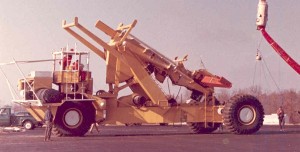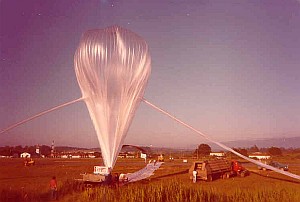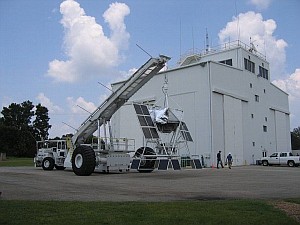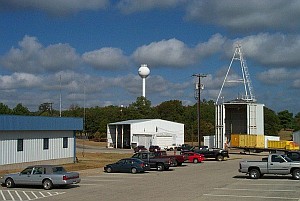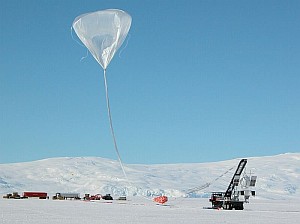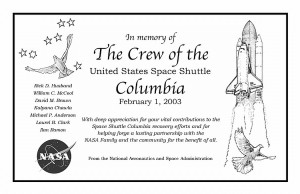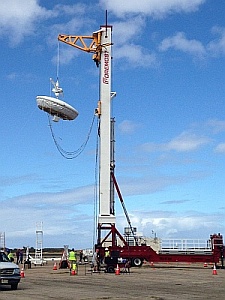This article takes the information provided by UCAR and adds my perception of activities and changes at the NSBF (CSBF) over the years. The intention is to provide people with an overview. A definitive and accurate history of the NSBF, the NSF Balloon Program, the NASA Balloon Program, and technological improvements and changes over the years requires an exhaustive and detailed study of records stored in several locations. More power to someone to do this research and write an exhaustive history of scientific ballooning in the US.
Scientific ballooning has proved to be a small, but vital program in the US for developing space sensors, training scientists to be successful in designing and building extremely expensive satellites and space science systems, and testing systems for further use in space payloads.
In the beginning
Scientific ballooning grew in the United States after World War II with the new use of polyethylene extruded film for balloon shell material. In the late 1950s there were six US groups performing balloon operations; U.S. Navy, U.S. Air Force, Winzen, Raven, Shjeldahl, and General Mills. At that time the reliability of polyethylene balloons was estimated about 50%. Support systems for balloon flights were rudimentary and limited. While there was some cooperation between groups, there was no focus to assist a scientist or prospective user of high altitude balloons to make effective use of this vehicle.
In June 1960, the National Center for Atmospheric Research (NCAR) was established by the University Corporation for Atmospheric Research (UCAR). One of the missions of NCAR was stated as follows:
"...To provide, cooperate in providing, or arrange for and support the provision of, national facilities for atmospheric research in such fields as ballooning, research aircraft, rockets, large-capacity compters, micro-meteorological networks, etc..."
Dr. Walter Orr Roberts, Director of NCAR and principal officer of UCAR called a meeting in December 1960 of government and university users to discuss scientific ballooning. The conclusions of this meeting were:
- Establish a Balloon Engineering Group at NCAR
- Appoint an NCAR Panel on Scientific Use of Balloons
Dr. Roberts took the first step by recruiting a staff for the Balloon Engineering Group within NCAR. Mr. Vincent E. Lally became the head of the group in June 1961 and a small number of engineers and technicians formed the nucleus.
The NCAR group negotiated with the FAA a set of operational rules that formed the basis for the excellent working relationship that has existed through the years. The next step was to determine a location for balloon flight operations. Dr. Martin Schwarzschild, Princeton University, had made one test flight from Hope, Arkansas. He was interested in using this site for future flights of his telescope experiment, Stratoscope. The NCAR group, with the assistance of the U.S. Weather Bureau, did a climatological study based on ballooning requirements which recommended a region of Arkansas, Louisiana, and northeast Texas for balloon flight operations.
The first meeting of the NCAR Panel on Scientific Balloon was held on 17 October 1961. Dr. Verner Suomi, University of Wisconsin was elected Chairman. Other members were James Angeli, Alvin Howell, Allen Hynek, Charles Moore, Edward Ney, and Martin Schwarzschild. Among other actions was the recommendation that NCAR establish a permanent balloon facility.
The site search for a permanent facility continued with help from the U.S. Weather Bureau and close collaboration with the FAA. Hope, Arkansas was the initial choice, but was turned down by the FAA due to an unacceptably high air traffic density. Crockett, Texas and Palestine, Texas were two sites under consideration. The choice of Palestine, Texas was approved by the FAA. The choice was approved on 26 March 1962 by the NCAR and a formal recommendation was submitted to the National Science Foundation. In April 1962 the City of Palestine and the National Science Foundation negotiated a base agreement for land adjacent to the Palestine Airport.
With Mr. Vincent Lally as the first NCAR Director of the facility, on 12 December 1962, the first flight was made from the Palestine launch pad, a test of the Stratoscope II launch system. This launch occurred after several months of construction at the site. The initial construction included a 6.5 acre paved launch area, a laboratory and operations building, and the Princeton University "Stratoport" which supported Dr. Schwatzchild's Stratoscope II telescope, and a staging and warehouse building.
Raven Industries was the first contractor to operate the newly established site. John Sparkman was appointed as the UCAR resident manager with Dick Keuser as the Raven Operations Manager. In 1963 twenty-five flights were flown from Palestine, Texas. During the year a study was made of using Page, Arizona as an alternate winter site. Six flights were made from Page, Arizona in 1963. The overall success rate during the year was approximately 50%. By the end of the year the staff at the Palestine facility consisted of 17 NCAR employees, 12 Raven employees, and two US Weather Bureau staff.
The first full year of operation was 1964. A total of 83 flights were flown, 15 of which were test flights. Of the scientific flights, 71% were successful. "Tiny Tim", the new launch vehicle specifically designed to support balloon operations, was built and delivered to NSBF in March 1964. The failure rate of balloons at the mid-latitude tropopause raised questions about balloon performance in the very cold tropical tropopause. A series of test flights were flown from Panama in August 1964 resulting in a contract to Winzen to provide balloons for the International Quiet Sun Year (IQSY) program managed by NCAR. The acquisition of land west of the existing NSBF facility was started to support a project known as CLAMSHELTER, a large structure to protect balloons during launch operations. Engineering problems and budget issues forced cancellation of this concept with the new land destined to be turned into the new large launch pad. Mr. Alvin Morris succeeded Mr. Vincent Lally as the Director of the Balloon Facility while Mr. Lally became head of another NCAR program.
Between 1965 and 1970 the scope of scientific balloons flights increased with an average of 86 balloon flights per year and a maximum of 98 in 1967. The success rate of scientific balloon flights during this period steadily increased from 68% to 84% in this period. Operational campaigns were performed in Hyderabad, India, Alegrete, Brazil, Litchfield Park, Arizona, Sioux Falls, South Dakota as well as Palestine, Texas and Page, Arizona. Improvements in electronic support systems and development of the Stonehenge launch system plus new balloon fabrication materials were accomplished during this expansive period. UCAR took over the work force at the balloon facility in 1967 rather than utilize contracted operational support staff to provide better continuity and efficiency.
The golden age
In 1970 the success rate of 85% was maintained with a total of 83 flights during the year. Flights operations were conducted in Parana, Argentina, Lakehurst, New Jersey, Minneapolis, Minn., Hobbs, New Mexico, Socorro, New Mexico, and Chico, California. In addition balloon facility staff supported American scientists on five flights from Australia. A conversion of Tiny Tim from a three wheeled to a four wheeled vehicle was made with modification of the steering system from electric control to proportional hydraulic control. This change reduced the pavement loading and improved the steering capability of the vehicle. A cryogenic hydrogen inflation system was developed in Palestine and considered suitable for field use.
The Balloon Panel met in May 1970 and endorsed three main fields of development that drove the program for the next five years. First, increase long duration balloon capability for zero pressure flights up to 72 hours, super pressure flights for several weeks, and launching balloons up to a volume of 100 million cubic feet. Second, improve flight data bandwidths for science support. Third, pursue development of a high quality balloon facility in the Southern hemisphere.
In April 1971 Mr. Alfred Shipley became the Director with all staff being consolidated into one group in Palestine, Texas. Planning for a new payload staging building and launch pad was started; these facilities to be located on the 295 acre site west of the present facilities. Improvements were started in the Consolidated Instrument Package (CIP) as well as using Omega for flight navigation. Over the next several years new electronic data and navigation systems were implements improving system reliability and data bandwidth. Flight success rate oscillated between 1971 from 1975 from 81% to a high of 89.5 % in fiscal 1975. In this period balloon reliability oscillated with electronic system reliability improving.
Balloon flights during this period were launched from Toowoomba, Australia and Sioux City, Iowa, Parana, Argentina, Rio Cuarto, Argentina, Midland, Texas and Hope, Arkansas, with the majority of flights initiating from Palestine, Texas. In March 1973 a super pressure balloon launched near Brisbane, Australia completed two orbits of the earth at 23 to 30 degrees south latitude. The flight was terminated by command and the payload recovered 9 miles from the launch site. This was the first planned recovery of a global flight. By the end of fiscal year 1975, the NSBF had completed over 1,000 balloon flights including 894 from Palestine, Texas.
In the period between 1975 and 1978, NSBF continued refining operational capability with better computers, up graded flight electronic packages, development of a ranging system, more capable tracking aircraft (replacing the Cessna 310J with a Cessna 410A), and development of a simple ranging system using the flight telemetry system. Operational techniques were improved with flight readiness reviews, standard procedures for taking low-level wind sounding, and acquisition of an MPS-19 auto-track radar system. In July 1978 the new staging building was completed and put into use after a number of budget delays.
The development of a better long duration flight capability started with a detailed study in 1977 of a dual balloon system using a zero pressure balloon for weight carrying and a super pressure sphere for ballast. Development of the Sky Anchor system included a large number of test flights through 1982 with mixed results.
By 1977 NSBF experienced an increased failure rate on heavy load flights (defined as having a total suspended weight in excess of 1,500 Kg) from around 25% to 43% in the previous two years. Investigation was focused into two areas: launch dynamics, and balloon design. NASA placed a moratorium on heavy load flights for all NASA funded experiments. A NASA Heavy Lift Balloon Review Committee proposed a six month NASA funded program of testing and development of heavy lift balloons. Over the next few years improvements in balloon design, use of a soft collar restraint during launch, a new 36 inch launch spool, and improved balloon QA resulted in a marked increase in success of heavy load flights resulting in NASA lifting the moratorium in March 1979.
Initial effort to use the INMARSAT global capability, NASA Tracking and Data Relay Satellite System (TDRSS), and SMS/GOES satellite in support of long duration ballooning was made by NSBF between 1978 and 1980. Balloon flight hardware for GOES was procured and flight tested. In the area of balloon design improvement the first flights of balloon with external caps, versus internal caps as previously constructed, were made at Palestine. The external caps added protection to the gas barrier during launch and also provided better balloon structural support at float altitudes.
In September 1981 a Sky Anchor flight was launched from Greenville, South Carolina. The system floated for 43.5 hours before being terminated in western Oklahoma. This flight established the feasibility of extended duration flights from a location in the eastern USA. During the mid-80s, a number of engineering advances were made in balloon systems. These included:
- Design of a new balloon helium valve
- Design of an automatic burst detector
- A computer augmented platform for telecommunication and navigation of LDB flights (CAPTN)
- Construction of an Omega data sampling receiver for LDB flights
- Work on linear low-density polyethylene (LLDPE) balloon grade film
- Testing of a new technique for launching heavy payloads
- Work on a new super-pressure design concept
As the 1980 decade started, NASA became a larger part of the NSBF mission. In May 1981 NSBF supported the Atmospheric Science Correlative Measurement Program involving multiple experiments on three gondolas designed to be launched in the same air mass. In 1982 the Stratospheric Balloon Intercomparison Program was supported. This consisted of four balloon launches conducted within a period of three and a half hours. In 1983 the sponsorship of the facility and program was transferred from NSF to NASA. The NASA Balloon Working Group of scientists was established for the purpose of counseling NASA on the performance and management needs of the NASA Balloon Program including the operation and support of the NSBF. The NASA Balloon Program management came under the NASA Wallops Flight Facility Suborbital Program structure with Mr. Larry Early as Division Manager and Mr. Harvey Needleman as Balloon Program Manager. The NSBF continued to be managed and staffed by UCAR with Mr. Alfred Shipley as the Director.
Increased balloon reliability issues, particularly with heavy payloads in the early-1980s, resulted in improving the materials testing capability at NSBF. Additionally increased monitoring of film extrusion and balloon manufacturing was started on a full time basis. A NASA program to create a stable of standard balloon designs was started along with qualification of balloon films to improve reliability. A NASA designed test program to qualify film and balloon designs was instituted with both current film extruders and balloon manufacturers, Winzen International and Raven Industries. By the mid-1980s, the Raven "Astrofilm-E" and Winzen "SF-372" were NASA certified as a film for qualified balloon designs.
The increased number of catastrophic balloon failures in the early 80s created operational problems in being able to separate the payload/parachute from the balloon so the falling balloon did not foul the payload parachute. This manually commanded separation operation from the ground had to be performed within a few seconds of the balloon failure. A flight system "burst detector" was developed by NSBF engineers to make this operation automatic. This hardware device was placed at the top of the parachute near the explosive cutters which caused the parachute/payload separation from the balloon. Though a spring loaded microswitch, loss of lift from the balloon was detected immediately and triggered the explosive cutter. The "burst detector" continues to be used on flights systems after 25 years of reliable operation.
Balloon operations in the 1980s involved a trend toward more remote and foreign based launches. Flight campaigns were supported in Brazil, Kauai-Hawaii, and South Carolina in 1981. In 1982 there were flight campaigns to Greenville, SC, Thompson, Canada, and Malden, MO. The occurrence of the Supernova SN1987A in 1987 resulted in a total of 24 flights in six campaigns from Alice Springs, Australia in support of gamma ray experiments. Ft. Sumner, NM had been selected as a launch site for stratospheric "turnaround" flights versus Palestine after a decision was made to eliminate flights traveling east of Palestine due to safety issues on payload and balloon recovery.
During the 80's several principal investigators in the science community were advocating the necessity of longer duration balloon flights to meet their science requirements. A minimum of five day flights at altitudes above 100,000 feet drove the NSBF to plan for two zero pressure balloon flights launched from Alice Springs, Australia with a planned termination in Brazil, South America.
The total number of balloon flights per year was averaging around 50 in the early 1980s. This number decreased over the decade with 46 flights in fiscal 1988, 22 flights in fiscal 1989, and 27 flights in fiscal 1990. The tendency during this period was for larger, heavier, and more complicated payloads involving physics, gamma ray, and infrared astronomy experiments with fewer atmospheric science experiments. By the end of the decade, the success rate of balloons and science was approaching 95%.
A Change of Direction
In the mid-1980s NASA decided to open the contract for engineering support of the NASA Balloon Program and operations of the NSBF to competition. This was the first open contract competition involving NSBF staffing. A major concern for NASA was retaining the skilled staff at NSBF during a possible contractor transition. Skills for balloon operations are not taught in any school. The only source of skilled staff was NSBF or the Air Force Balloon Program out of Holloman AF Base in Alamogordo, NM. At least four proposals, including the incumbent UCAR, were submitted to NASA for evaluation. In July 1987 NASA announced the award of the contract to the Physical Science Laboratory of New Mexico State University.
PSL/NMSU took over the management of the NSBF on October 1, 1987. During the transition period between contractors, balloon launch operations were being performed in Prince Albert, Canada and also being planned for Alice Springs, Australia. PSL hired all of the incumbent operational staff and most of the engineering and support staff. The PSL Program Manager, Art Gilcrease, the NSBF Site Manager, Dwight Bawcom, and the NSBF Administrative Manager, Terri Kuenstler, were the only current PSL/NMSU staff moved from Las Cruces, NM to Palestine, TX. A large majority of the technical support staff transitioned to the PSL/NMSU.
Support of the NASA Balloon Program operations under the new contract continued to go smoothly with a launch crew leaving Palestine for Alice Springs, Australia just a few weeks after the contract changeover. This was a particularly critical time for operations due to the initiation of the NASA program to collect gamma ray science data from Supernova SN1987A with a number of high priority balloon payloads in May 1987. Over the next two years a total of 24 balloon flights were launched from Alice Springs in six separate campaigns.
A NASA flight safety analysis in 1987 resulted in limitations for NSBF to launch balloons flying east of Palestine, TX and created a no-fly zone (roughly anything that would fly over a line between Oklahoma City and Dallas, TX) for balloons going east of Ft. Sumner, NM. In 1992 NSBF established a balloon launch site near Daggett, CA with the goal of launching balloons to fly east into the panhandle of Texas for flight termination. While the concept appeared attractive, a couple of things proved to make it untenable; poor weather conditions at the launch site, air traffic control limitations. Since that time, the operational concept for routine support of Line-of-Sight zero pressure balloon flights in the CONUS has been stratospheric turn-around flights from Ft. Sumner, NM and flights traveling west from NSBF in the summer. Pre- and Post-turn around flights from Ft. Sumner are supported using NSBF as a downrange station for easterly going flights and Holbrook, AZ for flights going west.
The need for a transportable payload launch vehicle to handle increasingly heavy payloads resulted in the design and purchase of the Mobile Launch Vehicle (MLV). The large NSBF based payload launch vehicle, "Tiny Tim", is not able to be moved from NSBF due to its extremely wide wheelbase and inability to be easily disassembled. The uniqueness of the vehicle specifications resulted in NSBF being tasked to design and fabricate the MLV after a commercial procurement attempt was untenable. The design and construction was tasked to PSL/NMSU in Las Cruces, NM This unique, one-of-a-kind, vehicle was delivered to Ft. Sumner, NM in 1991 and qualified to handle payload weights up to 8,000 lbs, 1500 pounds more than Tiny Tim could handle.
A science requirement by Dr. Parnell for a minimum of five days flights was the initiation for NSBF to support Long Duration Balloon flights. The initial concept was to adapt Line-of-Sight instrumentation and systems to support these flights with minimal monitoring using the ARGOS satellite system. The NASA Long Duration Ballooning project started at NSBF in early 1987 resulted in the launch of two LDB zero pressure balloons from Alice Springs, Australia in early 1988. The plan for both of these flights was to circumnavigate half the globe with flight terminations in Brazil after 7-10 days of flight. An NSBF team was stationed in Brazil with assistance from the Brazilian ballooning organization at INPE to implement the payload recovery. Both balloons ultimately made the flight to Brazil. Neither one had any real time over-the-horizon commanding capability. Each carried about 3,000 lbs of ballast with an auto-ballast system controlling ballast drops. One of the flights was almost perfect staying above 100,000 feet altitude over 95% of the flight. The other flight was almost a disaster! The auto-ballast system did not function during the first few days and no ballast was dropped. As the balloon approached Africa it appeared that it would likely drop back into the tropopause and return to the ground. For some unknown reason, more than likely due to a near-by electrical storm, the payload dropped all of the ballast, shot up to 130,000 feet altitude and crossed the lower part of Africa and south Atlantic Ocean continuing to Brazil. The balloon flight was terminated by LOS command in Brazil by NSBF staff and the payload came down on top of a house in a small town west of the coast. The 1500 lb payload penetrated the roof of the house, but no one was injured. NSBF was able to negotiate settlements for damage and retrieved the payload.
The Long Duration Balloon era
These two flights were the impetus for NASA to initiate a project to develop systems specifically designed to support LDB flights. These two flights in January 1988 were basically modified line-of-sight control systems modified to meet the LDB flight requirements with Argos for snap shot balloon flight status via satellite and LORAN for navigation/position. The science community was very interested in carrying heavy (minimum of 3,000 lbs) for long duration flights in mid-latitudes. This priority was expressed through the NASA Balloon Working Group meetings establishing a goal of 10 days with 3,000 pound payloads above 100,000 foot altitude.
A team of NASA and PSL/NSBF staff was formed in 1989 to provide a conceptual design for future LDB systems. The goal of this effort was for mid-latitude LDB flights. However, during the initial deliberations, the NASA Balloon Program Office changed the goal to supporting polar latitude flights suitable for launch from McMurdo, Antarctica and Alaska. A PSL/NMSU project team was named with oversight from the NASA-WFF Balloon Program Office. The first flights of the new LDB system were made in January 1989. A system design issue resulted in mission failures for both flights. One modified LDB system was launched at McMurdo, Antarctica in December 1990 resulting in a successful one orbit mission.
Throughout the 1990s and into the first decade of the 21st century, LDB support systems and scientific payloads have been refined with increased reliability, pre-mission testing, and scientific data real time downlink bandwidth plus on-board data capacity. In the mid-1990s, NSBF staff worked with Motorola to develop a "cheap" transponder for the LDB system to utilize the NASA TDRSS capabilities. This transponder improved uplink and downlink capability and reliability. In the 18 years since 1989, approximately 35 LDB flights have been launched from McMurdo, Antarctica. The longest LDB flight was over 40 days making three orbits around Antarctica. The NASA LDB capability has proven to be a reliable and affordable vehicle for researchers doing state of the art science and developing new sensor systems.
The operational support philosophy of NSBF during the 80's was basically a fixed base operation with a heavy flight schedule in the spring and the fall, one or two remote campaigns in the summer, and flight hardware maintenance during the winter months. With the large number of Australia campaigns in the late 80's, increased number of flights from Ft. Sumner, NM, an a yearly 8-10 week campaign to Antarctica starting in late October each year, plus at least one remote CONUS campaign, operational staff adapted to a very high travel schedule and little or no downtime for flight system maintenance. The staffing plan was modified to accommodate two fully staffed campaigns in the field and a limited operational capability at NSBF all at the same time. Routine flight campaigns in the 90s included a number of years going to Lynn Lake, Manitoba, Canada launching two to four payloads using a remote downrange LOS station is Prince Albert, Saskatchewan, Canada to support flights terminated in the Peace River region in Alberta, Canada. A plan to move the MLV to Lynn Lake to support balloon launches was researched, but the vehicle was never transported to that location.
The increased emphasis of LDB flights from Antarctica during the 90s resulted in infrastructure changes at the NSBF. An LDB payload integration building was designed and constructed at NSBF near the existing payload staging facility. This high bay facility accommodated two payloads with a monorail crane to move heavy payloads. The existing large thermovac chamber was installed in this building as well as an operations center to support LDB flights. In this same period NASA approved funds to improve the parachute and rigging shop and totally remodel the NSBF administration facility. A new engineering and management office building was also constructed at NSBF. At the same time NASA made a decision to establish a permanent facility at Ft. Sumner, NM with the purchase of land at the Ft. Sumner airport. A new large high bay payload staging and integration facility was constructed which also included an operations center for balloon flights.
After NASA assumed the management of the NSBF in 1983, the focus of the scientific payloads changed over the next decade. Atmospheric science payloads dominated NSBF operations in the early to mid-80s. Most of these flights emphasized payloads with one PI and a number of graduate students. Atmospheric payloads continue to be flown under the sponsorship of the NASA Upper Atmospheric Research Program. However, the number of flights now are only one or two per year. Cosmic ray, gamma ray, and high energy particles physics experiments started to dominate with the Supernova flights in 1987. The NASA Balloon Working Group pressed for heavier payload capability, the ability to routinely support a minimum of two payloads in Antarctica, and move to a three payload launch capability. As LDB system capabilities improved, scientific payloads become more complex with teams of multiple PI's, post-doctorate researchers, and graduate students. The relatively low reliability of scientific payloads that was acceptable in the 80s with the ability to fix and re-fly a payload become untenable as routine launches from Antarctica were established in the 90s. Flight system and payload integration testing requirements prior to shipping systems to Antarctica were established by the NASA BPO to ensure a higher probability of science success on Antarctica flights.
In the late 90's the NASA Balloon Program Office established the Ultra Long Duration Balloon Project. The initial goal of this project was to establish the capability of supporting a 1,000 lb scientific payload at 120,000 foot altitude for 100 day flight duration with a "pumpkin" shaped super pressure balloon utilizing new high strength films. NSBF issued a competitive RFP for the development of the new ULDB balloon. Raven Industries won the contract producing the first scale test balloons. The NSBF and PSL/NMSU were involved in the design of balloon pressure control systems and instrumentation support systems. Initial balloon designs showed promise, but as the balloon sizes were scaled up, balloon design and operational reliability were restricting factors resulting in significant project delays. By 2007 a number of redesigns and test inflations appear to resolve the reliability issues. Smaller test balloons were being constructed for flight testing in 2008.
As the LDB flight support systems evolved and became reliable, NSBF supported LDB flight attempts from Fairbanks, Alaska traveling west over Alaska, Russia, Sweden, Norway, Greenland and Canada. In 1998 one LDB flight was successfully flown from Fairbanks and terminated in northern Canada. The ability to negotiate permission to over-fly Russian territory proved to be problematic. The following year the NSBF campaign had to be cancelled days prior to launch when Russia refused to allow over flight. No further balloon flights have been attempted from Fairbanks, AK. However, NSBF started negotiations with the Swedes to launch LDB flights from Esrange in Kiruna, Sweden for flights going west to northern Canada or Alaska for flight termination. In addition the NASA Upper Atmosphere Research (UAR) Program had requirements to launch payloads in the Arctic atmosphere for short flights. As flight operations from Kiruna became routine going into the first decade of the 21st century, the relationship between NSBF, the NASA Balloon Program, and the Swedes has proved to have been reliable and good for LDB flights in the Arctic as well as UAR requirements.
The balloon facility today
Bellow can be seen a satellite image of the CSBF area. The "crab-like" land feature at right is the former launch pad which was used until the paved circular area at left was built. In the middle lie all the buildings of the base.

At the turn of the century, a number of management changes started. Dwight Bawcom retired as NSBF Site Manager in October 2000. Phil Copeland became the NSBF Site Manager until 2002 when he resigned and Danny Ball became the manager. Around the same period Mr. Harvey Needleman retired as the NASA Balloon Program Manager with Mr. Steve Smith taking over that position. In 2005 Mr. Smith resigned and Mr. David Pierce took over the management of the NASA Balloon Program. Mr. Steve Hottman became the PSL/NMSU Program Manager of the contract managing the NSBF and providing engineering support to the NASA GSFC/WFF Balloon Program Office. In October 2007, PSL/NMSU passed the 20 year anniversary of managing NSBF through three contract re-competitions.
The NSBF became a focal point for the recovery of the debris from the Space Shuttle Columbia disaster. The recovery teams that scoured east Texas for parts and debris brought much of that material to NSBF for documentation and classification. The NSBF main integration facility was used for this purpose for a number of months. In 2006, NASA renamed the NASA National Scientific Balloon Facility to the NASA Columbia Scientific Balloon Facility (CSBF) in honor of the space shuttle astronauts.
The first decade of the 21st century sees CSBF continuing to evolve and improve balloon flight systems. CSBF has used the in-line parachute configuration for payload recovery since the beginning of the facility. Over the years this has proved to be a very reliable configuration for payload recovery. However, one of the issues has been parachute opening shock. As opening shock issues have resulted in payload damage and destruction, gondola specifications and certification techniques have been established over the years to minimize the issues. In the late 1980s a gondola certification program was established with the basic requirement to substantiate the ability of a gondola to withstand a 10g opening shock. A couple of NSBF projects over the years to mitigate the opening shock proved to be ineffective (Central Load Core Project), and shroud line rip stitch. Recently a termination system rip stitch system designed by Pioneer Parachute Co. has proved to be an effective method of significantly reducing the opening shock.
The ability to cut-away the parachute after the payload impacts on the ground has proved to be a difficult issue to accomplish reliably without adding a significant weight to the system and potentially causing payload damage. In the past few years, CSBF has developed a safe and reliable automatic release system using the existing CSBF flight hardware with a small instrumentation package and processing system. This system has proved reliable in several flights launched from McMurdo Station, Antarctica.
After 10 years of successful balloon launch operations at McMurdo Station, Antarctica NASA, CSBF, and NSF coordinated to design and construct a set of portable facilities to support NASA balloon operations at Williams Field on the Ross Ice Shelf. These facilities consist of two 25 foot tall units to support the assembly, testing, and integration of payloads. Three other portable units include a workshop, a telemetry station with two dome protected antenna dishes, and a dual generator power unit. Each unit is mounted on skids which enables them to be moved for storage after balloon operations are complete each season. These units have provided the assets to reliably support balloon operations on the Ross Ice Shelf where the unit must be relocated each season due to the movement of the ice.
A vehicle to perform reliable dynamic payload balloon launches on the packed surface of the Ross Ice Shelf was designed by Foremost Corp from Canada. This vehicle is similar to the tundra tired vehicles used to haul cargo in Antarctica and has now provided a stable reliable launch system. The addition of this asset at McMurdo Station improved safety for CSBF staff during launch operations as well as better maneuverability on the ice shelf.
The NASA ULDB project involving the development of Super Pressure Balloons(SPB) established a new balloon launching site at Wanaka, NZ in 2015. This mid-latitude southern hemisphere site enables NASA to support a goal of launching payloads designed to meet 100 day flight mission requirements and provide lower risk balloon flights that circle the earth. Three SPB campaigns have been conducted from Wanaka, NZ (2015,2016,2017) and development of an operational SPB vehicle continues.
NASA/CSBF supported a JPL effort to develop a next-generation parachute to use on future Mars missions. This project involved the development of a static launch balloon payload launch system to meet safety requirements for operations personal. The Low Density Supersonic Decelerator (LDSD) system involved a payload with an armed solid fuel rocket motor. A mobile tower was designed to lift the payload about 70 feet from the surface. The system was designed to enable the balloon and payload to be launched with no operations personal within a 500 foot safety radius of the tower. Two launch operations supporting the LDSD project were successfully executed at the Pacific Missile Range Facility (PMRF) on Kauai, Hawaii in the summers of 2014 and 2015. This static payload launch capability provides the NASA Balloon Program a wide range of capabilities to support safe balloon launch operations with a wide variety of hazards in payloads.
After 25+ years of operations under NMSU/PSL, NASA awarded Orbital Sciences Corp. the contract to support the NASA Balloon Program in 2014. Since that time after some corporate changes, Northrup Grumman Space Systems is the current contractor supporting the NASA Balloon Program
Throughout the life of the balloon facility in Palestine, TX the number of flights launched per year has grown, settled down, and then diminished. The number peaked in the late 70s and early 80s with 75 flights per year. It averaged about 40 flights per year in the late 80s and early 90s. At the turn of the century the average number of flights was about 25. Today the average has dropped to about 18 flights per year. Early in the life of scientific ballooning, payloads were basically laboratory experiments modified to fly on balloons. If they failed or did not reach their goals, they were recovered, improved, and flown again. Balloons and helium were relatively cheap and multiple flights for a payload were supportable. As payload weights increased, scientific experiments become more sophisticated and expensive. Balloon sizes increased, balloon cost rose, and operational support cost rose forcing the science community to improve experiment reliability at the same time the reliability of balloons and operational support systems was required to improve. Balloon flight reliability was about 85% in the 70s and 80s with some perturbations in film and balloon fabrication quality. Throughout the 80s and 90s balloon reliability increased to where it is currently maintained with a mission success rate of about 94%. The goal is for 100% reliable balloons, but the ability to improve to a 100% level for a product that is essentially 100% handmade and not subject to post-production inspection has proved elusive without very expensive techniques.
Acknowledgements
- The UCAR 25 year history booklet provided to former UCAR employees after PSL/NMSU took over the management of NSBF in 1987.
- Personal notes and diary during my tenure as NSBF Site Manager 1987-2000
- Conversations with current and retired NSBF employees
About the author
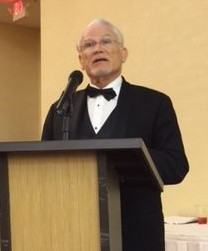
Dwight M. Bawcom: BS-Mathematics, Harding Univ. 1965, graduate study in Electrical Engineering at New Mexico State Univ. 1966. Full time working career of 34 years included 7 years as a telemetry engineer for NMSU, 3 years with Lockheed Electronics in data processing for NASA Space Shuttle reaction control engine testing, 3 years with Lockheed in Jeddah, Saudi Arabia installing and testing air traffic control systems, 3 years with Kentron International supervising telemetry systems operations and managing Range Engineering at Kwajalein Missile Range, Marshall Islands, 4 years with NMSU in technical management of NASA sounding rocket support, telemetry system support of the US Air Force Balloon Program, US Army telemetry system support, 13 years as the Site Manager of the NASA National Scientific Balloon Facility in Palestine, Texas under New Mexico State Univ.
After retiring in 2000 from NMSU, provided part time management support and technical support to the NASA Balloon Program in Antarctica including coordination of new support facilities for balloon operations at McMurdo Station. Recently worked with NMSU in the development of UAV operational capabilities at Las Cruces, NM.





